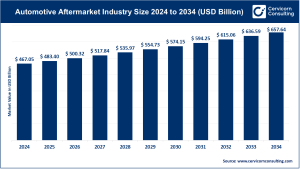Market Overview
The hydrogen internal combustion engine market is rapidly gaining momentum as a vital bridge between conventional combustion systems and the evolving hydrogen economy. Unlike hydrogen fuel cells, H2-ICE technology combusts hydrogen within a modified internal combustion engine—either spark-ignition or adapted gas engines—allowing manufacturers to capitalize on established production infrastructure and supply chains. This approach enables cost-effective decarbonization while maintaining performance and operational familiarity.
The global hydrogen internal combustion engine market is valued at approximately USD 33.82 billion in 2024 and is projected to reach around USD 104.86 billion by 2034, growing at a CAGR of 11.98% between 2025 and 2034. This impressive expansion highlights the technology’s potential to become a cornerstone in the global hydrogen value chain, with applications across heavy-duty transportation, marine propulsion, stationary power, industrial machinery, and off-highway equipment.
Get a Free Sample: https://www.cervicornconsulting.com/sample/2785
Key Market Trends
1. Surge in Engine Conversions and Retrofits
Leading OEMs are increasingly adapting existing combustion engines to run on hydrogen, a strategy that leverages current manufacturing ecosystems while minimizing capital expenditure. This “H2-ready” trend is evident in heavy-duty trucks and generator sets, offering faster commercialization compared to entirely new engine designs.
2. Policy Support and Hydrogen-Friendly Regulations
Global policy frameworks are integrating hydrogen as part of national decarbonization strategies. Incentives such as tax credits, subsidies for hydrogen refueling infrastructure, and low-emission vehicle mandates are accelerating the adoption of H2-ICE technology among OEMs and fleet operators.
3. Expansion of Hydrogen Infrastructure
The rapid scale-up of green hydrogen production and investment in storage and refueling networks are major enablers. As infrastructure matures, hydrogen-combustion engines become more commercially viable and easier to deploy across logistics and industrial applications.
4. Broader Application Spectrum Beyond Passenger Vehicles
Unlike hydrogen fuel cells that primarily target passenger cars, H2-ICE technology is gaining traction in sectors such as heavy transport, mining, marine, and stationary power generation, where high load demands and existing engine familiarity make it a practical transitional choice.
5. Rise of Hybrid and Dual-Fuel Configurations
Manufacturers are exploring dual-fuel (hydrogen + diesel or natural gas) and hybrid hydrogen-battery configurations to enhance operational flexibility. These solutions help fleet operators transition progressively to hydrogen while maintaining compatibility with current fuel infrastructures.
Market Drivers
- Decarbonization and Emission Targets: Global emission standards for heavy-duty and industrial sectors are prompting manufacturers to explore hydrogen as a clean combustion alternative.
- Established Manufacturing Ecosystem: The adaptation of existing engine designs reduces R&D costs and accelerates time-to-market.
- Declining Hydrogen Production Costs: Falling renewable-energy prices and advancements in electrolysis are lowering hydrogen fuel costs, making H2-ICE more competitive.
- Infrastructure Expansion: Large-scale government and private investments in hydrogen refueling networks are eliminating a key barrier to adoption.
- Fleet Readiness and OEM Commitment: Leading fleets and OEMs are investing in hydrogen-ready engines, driving early commercial deployments.
- Cost Advantage in High-Duty Applications: For sectors where battery or fuel-cell systems remain cost-prohibitive, hydrogen combustion offers a practical and scalable decarbonization route.
The market’s 11.98% CAGR and projected value of USD 104.86 billion by 2034 underscore investor confidence and OEM engagement in this evolving domain.
Impact of Trends and Drivers
- By Application: Heavy-duty transportation, marine, and stationary power segments are benefiting most from retrofitting and hybrid system trends.
- By Region: Europe, North America, and Asia-Pacific—regions with robust hydrogen policies—are leading pilot deployments and early commercialization.
- By Supply Chain: Established OEM and component ecosystems in industrialized regions support faster product scaling and market entry.
- By Infrastructure: The proliferation of hydrogen refueling corridors and port hubs is fostering regional adoption clusters.
- By Fleet Economics: Improved total cost of ownership (TCO) through compatibility with existing systems is accelerating adoption among fleet operators.
Challenges & Opportunities
Challenges
- High hydrogen fuel costs and limited supply networks.
- Competition from fuel-cell and battery-electric alternatives.
- Certification, retrofit, and maintenance complexities.
- Need for large-scale manufacturing and service-network expansion.
Opportunities
- High-growth potential with projected 12% CAGR through 2034.
- Early commercial traction in heavy-duty, marine, and industrial power sectors.
- Favorable policy environments in Europe and Asia-Pacific.
- Dual-fuel and retrofit programs enabling cost-effective fleet transitions.
- Expansion opportunities in aftermarket services, retrofitting, and maintenance ecosystems.
Future Outlook
The hydrogen internal combustion engine market is on a clear trajectory of sustained growth. With the market poised to rise from USD 33.82 billion in 2024 to USD 104.86 billion by 2034, the sector promises both environmental and commercial value. Key developments expected over the coming decade include:
- Large-scale commercialization of H2-ICE across transport and industrial sectors.
- Wider adoption of hybrid and dual-fuel hydrogen systems.
- Rapid growth of hydrogen refueling infrastructure tailored to heavy-duty fleets.
- Expansion into emerging economies as hydrogen costs fall.
- Stronger OEM and component-supplier investments in hydrogen-ready platforms and service models.
In essence, H2-ICE represents a practical, transitional decarbonization pathway for emission-intensive industries. With supportive policy frameworks and accelerating technological innovation, stakeholders—from OEMs to hydrogen suppliers—stand to benefit from this fast-evolving market.
For a Detailed Overview, Contact: Cervicorn Consulting
